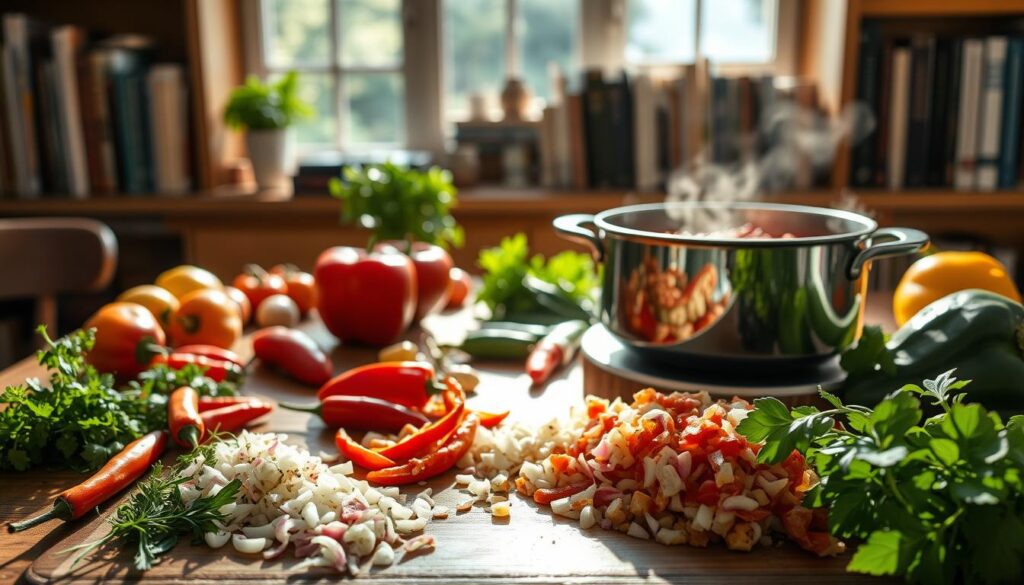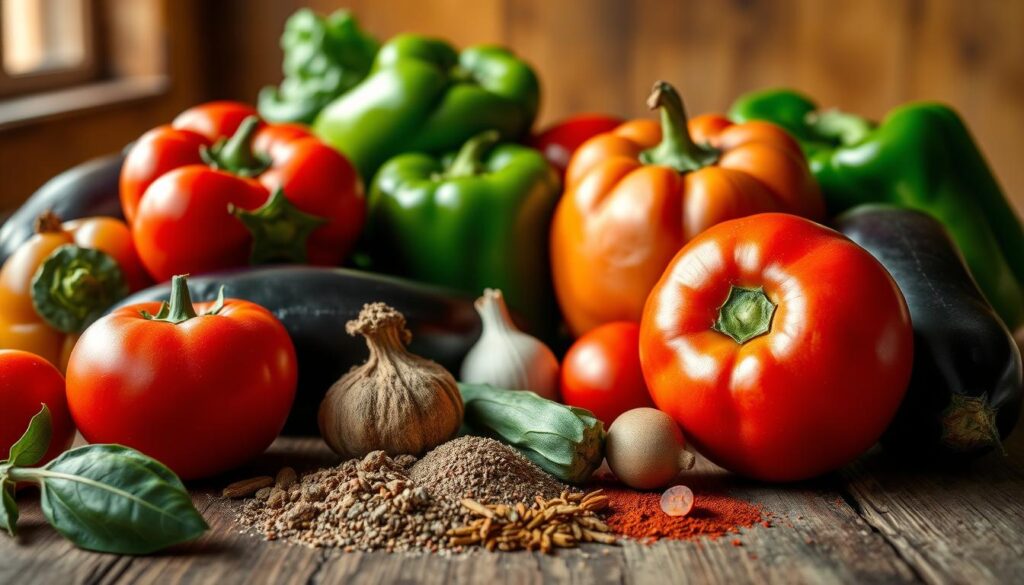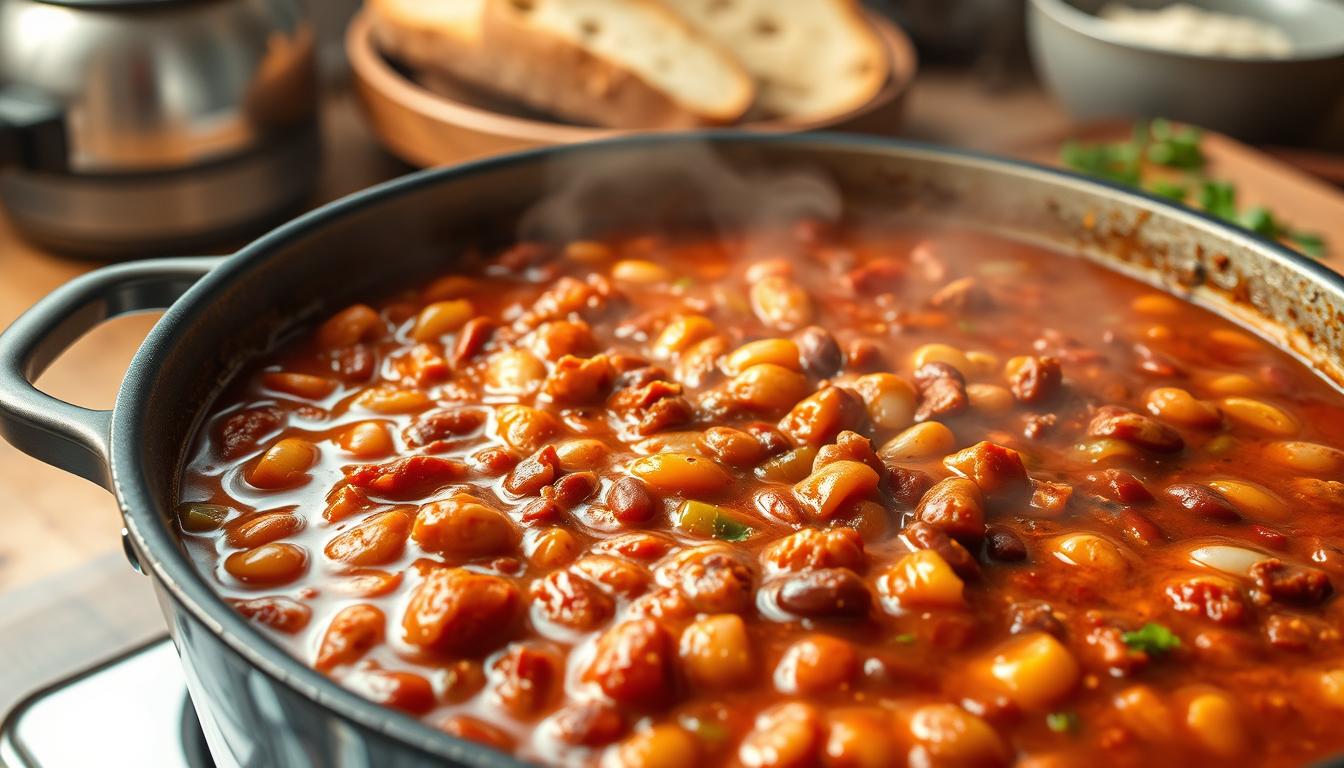Table of Contents
There’s nothing like a warm bowl of chili on a cold night. For years, I looked for a vegetarian chili that’s as satisfying as the classic. My Perfectly Spiced Vegetarian Chili is the answer—it’s meatless but full of flavor, comfort, and perfect for any group.
It’s like a big hug in a bowl. Thanks to smoky fire-roasted tomatoes and the bold taste of chipotle peppers in adobo sauce.
Key Takeaways
- Perfect for 4 large or 6 moderate portions, this hearty meatless meal feeds families or gatherings easily.
- Cooked in under an hour, with 30 minutes of simmering, it’s ready faster than you think.
- Uses Muir Glen BPA-free canned tomatoes and a mix of pinto and kidney beans for rich texture.
- Customizable with toppings like avocado or cilantro, and adaptable to vegan or gluten-free diets.
- Stores up to 5 days in the fridge or 3 months frozen, making it a kitchen staple.
Introduction: My Journey with Meatless Meals
My meatless meals journey started with small steps toward healthier eating. I was drawn to plant-based cooking and looked for recipes that were both comforting and nutritious. A New York Times article caught my eye with a chili recipe that used walnuts and mushrooms for texture.
The mix of chili powder and smoked paprika promised bold flavors. I knew I had to try it.

What Inspired Me
Online recipe reviews and friends’ success stories sparked my curiosity. The idea of a meatless chili that was substantial caught my attention. I was excited to learn how spices like cumin and oregano could enhance simple ingredients.
Discovering that the dish could be frozen or adapted for vegans made it even more appealing. It felt like a doorway to more adventurous meals.
My First Meatless Experiment
My first meatless experiment involved sautéed onions, garlic, and diced tomatoes. Walnuts added a meaty texture, while soy sauce enhanced the umami. Finding the right spice mix took some trial and error.
Initially, too much cumin overpowered the dish. But after adjusting the spices, I achieved a perfect balance of smoky, tangy, and earthy flavors. The result? A chili that even my meat-loving family enjoyed. It was easy to freeze and adaptable to different diets. That moment showed me that vegetarian cooking could be exciting.
Selecting the Finest Ingredients for a Flavorful Chili
Choosing the right ingredients for vegetable chili starts with fresh, seasonal produce. I pick crisp bell peppers, plump tomatoes, and earthy mushrooms for depth. When shopping, I look for firm vegetables without blemishes. This ensures every bite is full of natural sweetness and texture.

My pantry staples include whole spices like ancho and guajillo chiles. I grind them fresh for bold, authentic heat. For umami richness, I use tomato paste, soy sauce, and a bit of maple syrup. These ingredients create a savory base that balances smokiness and sweetness.
- Vegetable chili ingredients list:
- Fresh tomatoes or fire-roasted canned tomatoes
- Three types of beans (black, pinto, kidney) for protein
- Smoked paprika and chipotle in adobo for layered heat
- Optional additions: masa harina for thickness or red wine for complexity
Quality is key, even in small amounts. I toast spices like cumin and oregano briefly in a dry pan. This unlocks their oils. A spoonful of cocoa powder adds subtle richness without too much sweetness. Always taste as I go to adjust seasoning and highlight each ingredient’s best traits.
Essential Equipment and Techniques for Making Chili
Every great chili starts with the right chili cooking equipment and methods. Over time, I’ve learned that certain tools and steps make all the difference. They help create a rich, flavorful dish. Let me share what I rely on most.
My go-to essential kitchen tools include a heavy-duty Dutch oven, like my trusty Le Creuset. It distributes heat evenly. A large pot or slow cooker works too, but cast iron prevents acidic ingredients from reacting with metal.
A sturdy blender or spice grinder helps me prep ingredients smoothly. A mortar and pestle lets me freshly crush cumin and other spices.
Kitchen Tools I Trust
- Le Creuset Dutch oven for even heat retention
- Stainless steel mixing bowls for prepping ingredients
- Immersion blender for blending part of the chili for depth
Cooking Techniques I Embrace
My trusted cooking techniques focus on building layers of flavor. First, I sauté onions and garlic until translucent. Then, I deglaze the pan with beer or broth to capture caramelized bits.
Simmering on low heat for 30 minutes allows flavors to meld. I always let chili rest overnight in the fridge. It intensifies taste and thickens the sauce naturally.
Step-by-Step Preparation for a Perfectly Spiced Dish
Follow this step-by-step chili guide to make a hearty vegetarian chili. It’s easy to follow and every ingredient adds flavor.
- Heat 1 tbsp olive oil in a large pot. Sauté chopped onion, red bell pepper, and carrots until tender.
- Add minced garlic and jalapeño. Cook until fragrant, about 1 minute.
- Stir in tomato paste to coat vegetables, creating a base for spices.
- Combine drained beans, crushed tomatoes, broth, chili powder, cumin, oregano, salt, and pepper. Bring to a boil.
- Simmer uncovered for 30 minutes. Use an immersion blender to blend half the mixture for creaminess, if desired.
- Season with lime juice before serving to balance spiciness and acidity.
Top with shredded cheddar, sour cream, and cilantro. Adjust heat by adding more cumin or a pinch of brown sugar. This step-by-step chili guide helps you avoid overcooked veggies or under-seasoned broth.
- Drain beans thoroughly to prevent mushiness
- Add 1 tsp smoked paprika for deeper flavor
- Simmer uncovered to reduce broth to desired thickness
Mastering the Vegetarian Chili in My Kitchen
Creating a standout vegetarian chili takes skill in spice balancing and texture perfection in chili. Every step, from seasoning to garnishing, shapes the final dish. I blend proven techniques with my own touch for a dish that’s both comforting and unique.
Balancing Spices and Seasonings
Start with a base of cumin, chili powder, and smoked paprika. Then, add small amounts of adobo sauce or lemon juice. Taste often to avoid too much heat or salt.
A little apple cider vinegar can brighten flavors, while sugar can balance bitterness. I follow culinary blogs’ advice, making small changes to find the perfect balance.
Achieving the Ideal Texture
For texture perfection in chili, blend one-third of the chili to make it creamy. Keep the rest chunky for texture. Soak bulgur in boiling water for 20 minutes to add chewiness.
This method, inspired by Nathalie Dupree, keeps the chili hearty but not heavy.
Personal Touches That Enhance Flavor
Add your own touches like avocado crema or pickled onions. Yogurt can cool down the spice, while queso fresco adds saltiness. Sometimes, a spoonful of harissa adds a North African twist.
These small changes make the dish fresh every time I make it.
Cooking Tips for a Delicious, Protein-Packed Dinner
Make your vegetarian chili a filling meal with these easy tips. Start by soaking dried beans overnight to increase their protein. This is great for a protein-rich dinner.
Let your chili simmer uncovered to blend flavors well. Add beans last to keep them whole.
- Use a mix of black beans and kidney beans for 22g protein per serving, making this a satisfying vegetarian protein meal.
- Toast spices like cumin and paprika in a dry pan before adding liquid to enhance aroma.
- Add corn or quinoa at the end for extra fiber and protein.
- Store leftovers in airtight containers for up to 4 days or freeze for meal prep.
Adding a splash of apple cider vinegar can brighten the taste without adding too much heat. Try it with avocado or vegan cheese for more creaminess and protein. These tips make every bite hearty and nutritious!
Adapting the Recipe for Different Dietary Needs
Everyone deserves a hearty chili, but dietary needs vary. My vegetarian chili can easily become a vegan chili or gluten free chili. Here’s how to adjust the recipe without losing taste or texture.
Vegan Considerations
- Use plant-based broths and ensure all beans are unsalted and dairy-free.
- Add 1 tbsp maple syrup or balsamic vinegar to balance acidity without animal products.
/ul
Gluten-Free Variations
- Avoid flour-based thickeners; try cornstarch or pureed beans instead.
- Choose gluten free toppings like crushed corn chips or quinoa for crunch.
/ul
Serving Suggestions and Garnish Ideas
When I serve my vegetarian chili, I let guests add their own touches. They can choose from fresh garnish ideas and perfect chili toppings. These small touches turn a simple dish into a colorful feast. The right sides make each bite unforgettable.
| Category | Toppings/Sides | Notes |
|---|---|---|
| Fresh Toppings | Sliced avocado, cilantro, lime wedges, diced tomatoes | Add brightness and acidity to balance spice |
| Crunchy Add-Ins | Crispy tortilla chips, shredded lettuce, roasted veggies | Texture contrast for every bite |
| Creamy Options | Guacamole, vegan queso, or sour cream alternatives | Cool down heat while adding richness |
| Sides | Cornbread muffins, roasted sweet potatoes, or kale salads | Pair with hearty starches or light veggies |
My top chili serving suggestions are to let guests create their own bowls. They can add everything from hot sauce to cheese alternatives. For a kick, try adding jalapeños or crushed tortilla chips. Tangy sides like coleslaw or pickles also add a nice contrast. Trying out these perfect chili toppings makes every bowl special!
My Favorite Variations of Vegetarian Chili
Every year, I love to try new things with vegetarian chili. I change it up based on what’s in season or what spices I’m into. It’s always fun to see how different flavors can make the dish better.
Regional Flavors I Love
Exploring different flavors takes the chili to exciting places. I’ve made a New Mexico version with ancho, chipotle, and guajillo chilies and beer instead of broth. For a Midwest twist, I add smoked paprika and corn for sweetness. Here are some other great combinations:
- Tex-Mex: lime zest, pickled onions, and cumin
- Creole: garlic powder, celery seed, and a dash of hot sauce
- Southwestern: roasted Hatch chilies and cotija cheese
Seasonal Substitutions
Changing up the ingredients makes the chili versatile. In summer, I use zucchini and yellow squash. In winter, I add sweet potatoes or butternut squash. Here’s how I adjust the recipe by season:
- Spring: asparagus tips or roasted fennel
- Fall: kale or acorn squash
- Winter: shiitake mushrooms for umami depth
These changes keep the chili fresh and exciting. My freezer is always full of prepped veggies for any time of year.
Troubleshooting Common Cooking Challenges
Even seasoned cooks face common cooking challenges when making vegetarian chili. Here’s how to fix the most frequent issues using simple chili troubleshooting tips:
- Too Thin? Simmer uncovered to reduce liquid. Stir in masa harina or mashed beans for thickness.
- Overly Spicy? Add diced potatoes or a splash of dairy (like yogurt) to balance heat.
- Bland Flavor? Stir in 1 tbsp apple cider vinegar or soy sauce. Let flavors meld for 10 minutes.
| Issue | Solution |
|---|---|
| Grainy texture | Blend 1/3 of the beans for a creamier base |
| Watery broth | Stir in tomato paste or add roasted bell peppers |
| Stale spices | Discard old spices; test freshness by smell before use |
Always start with recipe troubleshooting tips like browning vegetables first for deeper flavor. If chili tastes flat, add a pinch of smoked paprika or cumin. Adjust seasonings gradually, tasting as you go. Never overcrowd the pot—cook in batches if needed. These tricks turn almost any mishap into a perfect bowl of chili every time.
Conclusion
In this vegetarian chili conclusion, I’m reminded that bold flavors and hearty textures can make a meal nourishing and soul-warming. Beans, smoky spices, and fresh veggies show that plant-based cooking doesn’t mean giving up. My journey showed how cumin, chili powder, and a slow cooker can turn simple ingredients into something deeply satisfying.
Final thoughts on chili highlight its adaptability. Whether you prefer vegan coconut milk or gluten-free cornstarch, this dish meets your needs. I’ve loved how a pot simmers on my stovetop or slow cooker, filling the kitchen with aromas that bring people together. The dish’s flexibility—swap in seasonal veggies like zucchini or corn—keeps it exciting every time I make it.
As this hearty chili wrap-up, I encourage you to experiment. Add a squeeze of lime, a sprinkle of nutritional yeast, or a dash of hot sauce to make it your own. This recipe isn’t just a meal; it’s a foundation for creativity. Freeze leftovers, adjust spice levels, and share the bowl with friends. Every spoonful of that veggie-forward, protein-rich mix of beans and barley warms my heart—and I hope it does yours too. Let me know how your version turns out! The kitchen is waiting.
FAQ
What makes this vegetarian chili recipe stand out?
My vegetarian chili is perfectly spiced and hearty. It’s a favorite comfort food on cold days. It’s meatless but still rich and fulfilling, making you want more.
Can I customize this chili recipe to my taste?
Absolutely! You can adjust the spices for heat. Add different beans or seasonal vegetables. Make it your own twist on this comforting dish.
What are the best ingredients to use in my chili?
Choose the best ingredients. Use fresh produce like ripe tomatoes, assorted beans, and bell peppers. Onions, carrots, and celery also enhance flavor and nutrition.
What kitchen tools do I need to make this chili?
A sturdy Dutch oven is best for even heat. You’ll also need sharp knives, wooden spatulas, and measuring cups. These tools help with preparation and cooking.
How do I ensure the right texture and flavor balance in my chili?
For the right texture, blend part of the chili. This creates a satisfying mouthfeel. Balance spices and seasonings by tasting as you go. Adjust to your liking.
Can I make this recipe vegan or gluten-free?
Yes, it’s easy to make vegan or gluten-free. Use vegan toppings instead of dairy. Choose gluten-free thickening agents if needed.
What are some creative garnishes for the chili?
Elevate your chili with avocado slices, fresh cilantro, and sour cream or vegan yogurt. Add zesty lime wedges for extra flavor.
How do I troubleshoot if my chili isn’t turning out as expected?
If it’s too thin or too spicy, adjust the consistency. Add broth or spices as needed. Taste often and adjust to your liking.
How can I store leftovers and reheat the chili?
Store leftovers in an airtight container in the fridge for up to five days. Freeze for longer storage. When reheating, add water or broth to adjust consistency.
SEE MORE : One-Pan Chicken and Veggies: A Flavorful Meal


